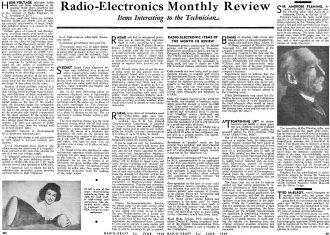|
June 1945 Radio-Craft
 [Table of Contents] [Table of Contents]
Wax nostalgic about and learn from the history of early electronics.
See articles from Radio-Craft,
published 1929 - 1953. All copyrights are hereby acknowledged.
|
Radio-Craft magazine ran
a regular feature entitled "Radio-Electronics Monthly Review," which reported on
industry news and events. The death of diode electron tube inventor
Sir Ambrose Fleming
appeared as a major item. He lived to the ripe old age of 95½ - an amazing feat
at a time when the
average lifespan
of a male born in 1949 was less than 40 years. Regardless of the year born, your
life expectancy increases as you get older both due to better available lifestyles,
nutrition, and medicine, and because you continually cross benchmarks of genetic
and environmental factors that take out others born in the same era. My life insurance
rate went down once I turned 60 for that reason. Another interesting item was the
call for more ubiquitous deployment of 2-way radios (walkie-talkies) in rural areas
to compensate for a relative lack of telephone service. That ushered in the
Citizens Radiocommunication
Service era.
Radio-Electronics Monthly Review
 Rural areas have an immediate need
for walkie-talkie radio, since telephone and wire facilities often are not available,
says E. K. Jett, Federal Communications Commission, as reported in Science Service
last month. Residents of small towns will be able to use walkie-talkie for reliable
two-way communication in a radius of up to 15 miles, he stated. Rural areas have an immediate need
for walkie-talkie radio, since telephone and wire facilities often are not available,
says E. K. Jett, Federal Communications Commission, as reported in Science Service
last month. Residents of small towns will be able to use walkie-talkie for reliable
two-way communication in a radius of up to 15 miles, he stated.
The apparatus will be tunable to various frequencies within the allotted band.
It can be used not only for communication between farms and small towns, but
also to keep/in touch with taxicabs, police cars and service trucks operated by
electric, water and transportation organizations and other types of businesses.
Reliable communication range of low power walkie-talkies will be limited in large
towns and cities because buildings will obstruct the path of radio waves being transmitted,
Mr. Jett pointed out. Rural areas are generally free of such obstructions. Furthermore,
because the demand for channels will be less in small towns than in large cities,
there will be greater freedom in respect to the availability of interference-free
channels for communication. Thus the new communications service will be more freely
available in rural and semi-rural areas where there is more need for it, and less
so in large cities, where it is easier to step into a phone booth than to carry
around a small radio transmitter.
Citizens Radiocommunication Service, the official name for the radio service
using "walkie-talkie," will be thrown wide open to any citizen who wants to use
it after the war. Requirements for a license are simple. All the applicant will
have to do is to certify that he has read the rules and regulations and understands
them. Licenses to own and to operate a radio station will run concurrently for five
years, after which time it will be necessary to get a renewal.
Beams of directed radio waves may take the place of transcontinental
telegraph pole-and-wire lines, Albert N. Williams, president of Western Union Telegraph
Co., told stockholders at the company's annual meeting last month.
Reviewing research in this field and the allocation of wave lengths to the company
for an experimental radio telegraph beam between Philadelphia and New York, Mr.
Williams said this point-to-point radio telegraphy was "one of the most dramatic
and interesting new possibilities" in the company's business.
Experiments tend to indicate that the maintenance of relay stations at the greatest
possible distances permitting line-of-sight paths between them may prove considerably
more economical than upkeep of the present lines. Interruption due to storm or flood
would also be reduced almost to the vanishing point.
(Such developments may cause the distinction between telegrams and radiograms
to disappear in time. A "wire" handed in at the local telegraph office would be
transmitted in the quickest way - probably part of the distance over wires and the
rest of the way through the ether.)
Posted October 26, 2021
|









